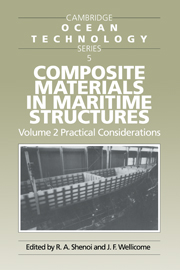Book contents
- Frontmatter
- Contents
- Preface
- List of Authors
- 1 Introduction
- 2 Design of Displacement Craft
- 3 Design of Dynamically Supported Craft
- 4 The Role of Adhesives
- 5 Practical Design of Joints and Attachments
- 6 Production of Ships with Single Skin Structures
- 7 Production of Yacht Hulls of Sandwich Configuration
- 8 Material Case Study - Failures and their Repairs
- 9 Response of Sandwich Structures to Slamming and Impact Loads
- 10 Fatigue Characteristics
- 11 Composites in Offshore Structures
- 12 Regulatory Aspects in Design
- 13 Quality and Safety Assessment
- 14 Design Management and Organisation
- Appendix
- Index
14 - Design Management and Organisation
Published online by Cambridge University Press: 04 August 2010
- Frontmatter
- Contents
- Preface
- List of Authors
- 1 Introduction
- 2 Design of Displacement Craft
- 3 Design of Dynamically Supported Craft
- 4 The Role of Adhesives
- 5 Practical Design of Joints and Attachments
- 6 Production of Ships with Single Skin Structures
- 7 Production of Yacht Hulls of Sandwich Configuration
- 8 Material Case Study - Failures and their Repairs
- 9 Response of Sandwich Structures to Slamming and Impact Loads
- 10 Fatigue Characteristics
- 11 Composites in Offshore Structures
- 12 Regulatory Aspects in Design
- 13 Quality and Safety Assessment
- 14 Design Management and Organisation
- Appendix
- Index
Summary
INTRODUCTION
The objective of design management is to provide a product design that meets the design brief in an efficient and cost effective manner. It is important that this activity is recognised and respected at all management levels and that the associated organisation is structured such that the activity can be effective. It is an activity that can equally well be practised by a large organisation or an individual, thereby ensuring an effective usage of time and resources leading to a well designed product.
In this instance attention will be given to FRP composite materials and their marine application. Products made in these materials which are likely to form a part of a total product, i.e., the hull of a vessel, the chassis of a ROV, part of an offshore structure, etc., will be discussed. Aspects of design management will therefore be directed at the design activity of these composite products, as opposed to the whole product conception. However, it will be necessary to discuss the role of management at corporate and overall project level, in order to put into perspective the need and role of managing the design activity.
Products involving composite materials require very close management because of the wide variety of choice between materials, processes and structural options. Add to this the complexities of building marine structures, all of which will be affected by weight, cost and the environment, and the importance of careful management increases.
THE NEED FOR MANAGEMENT
Design management is now a recognised subject, but has only recently received the attention it deserves. The driving factor has been better and more competitive products.
- Type
- Chapter
- Information
- Composite Materials in Maritime Structures , pp. 281 - 295Publisher: Cambridge University PressPrint publication year: 1993

